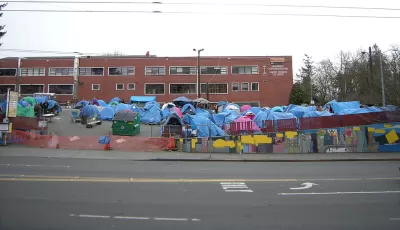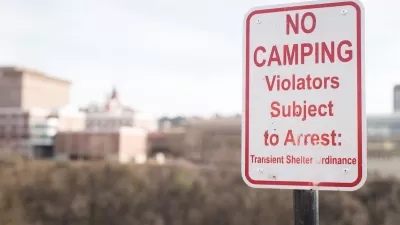New numbers from the U.S. Department of Housing and Urban Development show "devastating" growth in the number of unhoused people in the United States in January 2020.

According to new numbers from the U.S. Department of Housing and Urban Development (HUD), the growth in homelessness in 2020 was already having "devastating" effects even before the pandemic struck. Pam Fessler reports for NPR on HUD's annual Point-in-Time (PIT) count, "a count of sheltered and unsheltered people experiencing homelessness on a single night in January" mandated by the agency and conducted through local organizations. "On a single night in January 2020, there were more than 580,000 individuals who were homeless in the United States," up 2% from 2019.
Conditions for those living without permanent housing have also deteriorated. "For the first time since the government began doing the annual count, the number of single adults living outside — 209,413 — exceeded the number of individuals living in shelters — 199,478." The housing crisis has continued to have a disproportionate impact on communities of color, Fessler reports. "As has been the case for years, a disproportionate share of those experiencing homelessness were Black — about 39% of the total, though African Americans make up about 13% of the nation's overall population. Twenty-three percent of those who were homeless last year identified as Hispanic or Latino."
While the impact of the pandemic is expected to deepen the crisis, data for 2021 will be incomplete as HUD has agreed to exempt some localities from the PIT count to ensure the safety of volunteers. Advocates hope new federal assistance can help curb the crisis. The COVID relief bill passed by Congress "provides $5 billion in homelessness assistance, more than $20 billion in emergency rental aid and $5 billion in new housing vouchers."
FULL STORY: HUD: Growth Of Homelessness During 2020 Was 'Devastating,' Even Before The Pandemic

Planetizen Federal Action Tracker
A weekly monitor of how Trump’s orders and actions are impacting planners and planning in America.

San Francisco's School District Spent $105M To Build Affordable Housing for Teachers — And That's Just the Beginning
SFUSD joins a growing list of school districts using their land holdings to address housing affordability challenges faced by their own employees.

The Tiny, Adorable $7,000 Car Turning Japan Onto EVs
The single seat Mibot charges from a regular plug as quickly as an iPad, and is about half the price of an average EV.

With Protected Lanes, 460% More People Commute by Bike
For those needing more ammo, more data proving what we already knew is here.

In More Metros Than You’d Think, Suburbs are Now More Expensive Than the City
If you're moving to the burbs to save on square footage, data shows you should think again.

The States Losing Rural Delivery Rooms at an Alarming Pace
In some states, as few as 9% of rural hospitals still deliver babies. As a result, rising pre-term births, no adequate pre-term care and "harrowing" close calls are a growing reality.
Urban Design for Planners 1: Software Tools
This six-course series explores essential urban design concepts using open source software and equips planners with the tools they need to participate fully in the urban design process.
Planning for Universal Design
Learn the tools for implementing Universal Design in planning regulations.
Smith Gee Studio
City of Charlotte
City of Camden Redevelopment Agency
City of Astoria
Transportation Research & Education Center (TREC) at Portland State University
US High Speed Rail Association
City of Camden Redevelopment Agency
Municipality of Princeton (NJ)





























